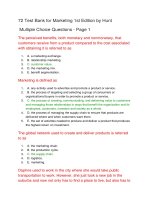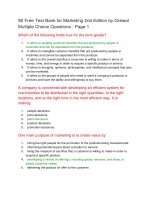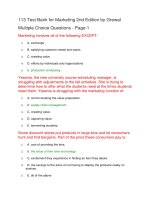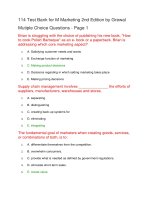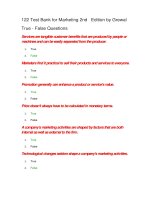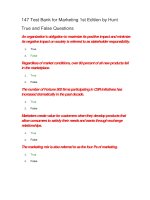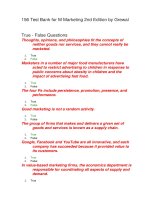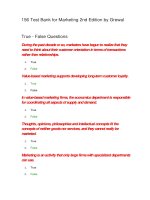Marketing 2nd edition by hunt mello deitz solution manual
Bạn đang xem bản rút gọn của tài liệu. Xem và tải ngay bản đầy đủ của tài liệu tại đây (4.19 MB, 110 trang )
Instructor’s Manual - Chapter 2
Hunt/Mello/Deitz:
Marketing 2e
Chapter 2: Strategic Planning
Link full download solution manual: />Link full download test bank: />Use this Instructor’s Manual to facilitate class discussion and incorporate the unique features of the text.
Encourage students to follow along using their LEARNING WORKSHEET, which is located in the Instructor’s
Online Resources. Students should attempt to complete the Learning Worksheet before class begins, allowing
class lecture and discussion to be a review of the material. Students should be able to access these Learning
Worksheets via their learning platform (Moodle, Blackboard, etc.). The worksheet key for Chapter 2 is
provided in the Instructor’s Online Resources.
CHAPTER FORECAST
This chapter explores the importance of strategic planning in marketing. Executing a thoughtful strategic
marketing plan is the most likely path to sustainable business success. The chapter examines the role of a
mission statement, situation analysis, marketing strategy, global marketing strategy, and other elements of
an effective marketing plan. The appendix that follows the chapter presents a complete sample marketing
plan.
LEARNING OBJECTIVES
LO 2-1 Discuss the importance of strategic planning for marketing.
LO 2-2 Analyze the characteristics of an effective mission statement.
LO 2-3 Outline the five main components of the marketing plan.
LO 2-4 Explain three tools and techniques for the situation analysis: market summary, SWOT analysis, and
competition analysis.
LO 2-5 Explain the basic tool and techniques of marketing strategy: segmentation, strategic direction, and the
marketing mix.
LO 2-6 Discuss the strategic decisions involved in reaching international consumers.
LO 2-7 Describe the use of four key marketing analytics: return on marketing investment (ROMI),
revenue analysis, market share analysis, and profitability analysis.
KEY TERMS
competitive advantage
direct ownership
diversification
exporting
financial projections
franchising
joint venture
licensing
market development
market penetration
market segmentation
market segments
market share analysis
market summary
marketing analytics
marketing plan
mission statement
opportunities (in SWOT
analysis)
positioning
product development
profitability analysis
return on marketing
investment (ROMI)
revenue analysis
situation analysis
strategic plan
strategic planning
strategy
strengths (in SWOT analysis)
SWOT analysis
target market
threats (in SWOT analysis)
weaknesses (in SWOT analysis)
Instructor’s Manual – Chapter 2 | Hunt/Mello/Deitz: Marketing 2e © 2018 by McGraw Hill Companies
Instructor’s Manual - Chapter 2
Hunt/Mello/Deitz:
Marketing 2e
THOUGHT-PROVOKING ACTIVITY
With each chapter, begin class with a thought-provoking activity (TPA) for 10 minutes. TPAs allow students to
pull in real-world, current findings into class, and better enable students to partake in class discussion with
relation to the chapter’s material in an icebreaker format. (This activity is included in the PowerPoint for this
chapter.)
How It Works: When class begins, two to three students are called on via random assignment to provide
their responses a minimum of one time in the semester. Two sets of activities are provided for either (1)
teaching one chapter over two class sessions or (2) allowing more students to partake in the activity.
Instructors can either collect the worksheets for a grade or asses a point value when students respond aloud.
Supporting Materials: A sample grading rubric is provided in the Instructor’s Online Resources. The
Learning Worksheet also references the TPA.
Set 1: What is a mission statement? Provide an example of a mission statement in a franchise.
Set 2: What is the BCG matrix? With each of the four sections, provide an example.
CONTENT OUTLINE
The following section provides the flow of information using the LEARNING OBJECTIVES as a guide, FIGURES
and TABLES as visuals to elaborate on key areas, and KEY TERMS learners will need to take away from the
course, and a notation of when to use POWERPOINT SLIDES with LECTURE NOTES to drive home teaching
points. There is also a reminder on when CONNECT activities can be used, as well as tying in SOCIAL MEDIA
IN ACTION to real-world applications of marketing products. This is created so that you can facilitate in-class
or online discussion effectively.
Executive Perspective
Josh Brown
Partner and Co-Owner, Haag Brown Commercial Real Estate
Josh Brown, political science major turned broker, attributes his
success to winning at small things since a young age. He
explains how taking responsibility for marketing yourself elicits
success in answering the following questions:
What has been the most important thing in making
you successful at your job?
What advice would you give soon-to-be graduates?
How is marketing relevant to your role at Haag Brown?
What do you consider your personal brand to be?
Photo provided by Josh Brown
Woven in the chapter, you see how Josh later elaborates on:
The role of strategic planning in an organization.
Why it’s important to clearly identify a firm’s market
position.
Review with students:
How is marketing relevant in his role?
What does he mean by saying, “...stay close to the coach
and be ready to play?”
Instructor’s Manual – Chapter 2 | Hunt/Mello/Deitz: Marketing 2e © 2018 by McGraw Hill Companies
Instructor’s Manual - Chapter 2
Hunt/Mello/Deitz:
Marketing 2e
LO 2-1
Discuss the importance of
Key Terms:
strategic planning for marketing.
• Strategic planning
• The Importance of Strategic
• Strategic plan
Planning
PowerPoint Slides
Lecture Notes:
PPt 2.6
• Essential to meeting both professional and personal objectives because it greatly
increases the likelihood of success
• What does strategic planning mean? To plan with strategy.
PPt 2.7
• Strategic planning – process of thoughtfully defining a firm’s objectives and
developing a method for achieving those objectives
o A continuous process – shifting conditions, customer needs, and
competitive threats are always present
o Helps us to ensure that marketers select and execute the right
marketing mix to maximize success
• Strategic plan – organization’s plans for key functional areas, such as marketing,
human resources, finance, and risk management
• Strategic planning is essential to meeting both professional and personal
objectives. In the same way that a strategic plan will help you accomplish your
goal of earning a college degree, a firm’s strategic plan helps guide it to success.
Figure 2.1
Insight Questions:
1. How often should firms go through strategic planning?
(Answer: Firms must continually modify their strategies as
conditions shift.)
2. How is the marketing mix affected by strategic planning?
(Answer: It helps marketers select and execute the right
marketing mix strategies to maximize success.)
3. How formal should the strategic planning process be, and
who should be included? (Answer: open ended, student
answers will vary; it should be well documented, and a
representative from each department should be included
in decision-making)
Figure Information: Elements of a Strategic
Plan
The four components of a strategic plan are
interlinked and connected. Each of the
components should be grounded in the
firm’s overall mission.
LO 2-2
Analyze the characteristics of an Key Terms:
effective mission statement.
• Mission statement
• Mission Statement
PowerPoint Slides
Lecture Notes:
PPt 2.9
• First part of a quality marketing plan
• A concise affirmation of the firm’s long-term purpose, and provides employees
with a shared sense of ambition, direction, and opportunity
• Drives other decisions a firm makes, including how to best get goods and services
to consumers
• Consider the following questions – they are challenging yet important:
o
What is our business?
Instructor’s Manual – Chapter 2 | Hunt/Mello/Deitz: Marketing 2e © 2018 by McGraw Hill Companies
Instructor’s Manual - Chapter 2
Hunt/Mello/Deitz:
Marketing 2e
Who is our customer?
What is our value to the customer?
What will our business be?
What should our business be?
Three primary characteristics of a good mission statement:
Focus on a limited number of goals
Customer oriented, satisfying the basic customer needs and wants o
Capture a shared purpose and provide motivation for employees
THINK LIKE A MARKETER
Find an example of a “bad” mission statement. What makes it “bad”? How could it be
better?
THINK LIKE A MARKETER
What do you think of a company not having a mission statement?
PPt 2.10
In pursuit of its mission statement to build the best products and implement
environmentally friendly solutions, Patagonia partners with a Long Beach
company, Upcycle It Now, to deconstruct old rain coats and fleece jackets and use
them to create dog attire.
LO 2-3
Outline the five main components Key Terms:
of the marketing plan.
• Marketing plan
• The Marketing Plan
• Situation analysis
o Executive Summary
• Market summary
o Situation Analysis
• Strategy
Marketing
Strategy
o
• Financial projections
o Financials
o Controls
PowerPoint Slides
Lecture Notes:
PPt 2.11
• Marketing plan – action-oriented document/playbook that guides the analysis,
implementation, and control of the firm’s marketing strategy
o Primary strategic planning tool
o Contains input, guidance, and review from various departments,
employees
o Essential that all departments know the plan
o Format will vary
o Contains (all grounded by the mission statement):
Executive summary
Situation analysis
Marketing strategy
Financials
Controls
Figure 2.2
Insight Questions:
1. Who is involved in developing the marketing plan? (Answer:
Most departments in a firm, not just the marketing
department.)
2. What types of objectives should be considered in the
marketing strategy? (Answer: specific, measurable, and
realistic objectives)
Instructor’s Manual – Chapter 2 | Hunt/Mello/Deitz: Marketing 2e © 2018 by McGraw Hill Companies
Instructor’s Manual - Chapter 2
Hunt/Mello/Deitz:
Marketing 2e
Should a marketing plan have a short-term or long-term
vision? (Answer: Both, and it should tie into the organization’s
mission for long-term sustainability.)
Figure Information: Key Components of the
Marketing Plan
The five components of the marketing plan
are interlinked and connected. Each of the
components should be grounded in the
firm’s overall mission, which is ideally
defined in a clear and succinct mission
statement.
PowerPoint Slides
Lecture Notes:
PPt 2.11
• Key Components of the Marketing Plan
o Executive summary:
Synopsizes the marketing plan’s main points in 1–2 pages
Briefly discuss the basic ideas and strategies behind your plan
Completed last
Elevator pitchof the marketing plan
THINK LIKE A MARKETER
What’s your elevator pitch? (Recall your work from Chapter 1’s Personal Marketing
Plan exercise.)
o
o
Situation analysis:
Foundation of the marketing plan (current situation understood
so the firm can best move forward)
Analyzes the environment with the following key sections:
• Market summary – describes the current state of the
market
o A market is the group of consumers or
organizations that is interested in and able to
buy a particular product.
o Understanding where a market is and where it
might be going gives organizations a view of
what resources to invest where.
• SWOT analysis – an evaluation of a firm’s strengths (S),
weaknesses (W), opportunities (O), and threats (T)
• Competition analysis – lists the firm's direct
competitors
o Indirect competitors are those that can take
market share as macro trends or consumer
preferences change
o Easier to identify direct competitors
Marketing Strategy:
Instructor’s Manual – Chapter 2 | Hunt/Mello/Deitz: Marketing 2e © 2018 by McGraw Hill Companies
Instructor’s Manual - Chapter 2
PPt 2.12
o
o
Hunt/Mello/Deitz:
Marketing 2e
Strategy – set of actions taken to accomplish
organizational objectives based on the mission
Defines the target market and outlines the positioning and
marketing mix strategies based on specific, measurable, and
realistic objectives
Lists the actions the firm must take to accomplish the
marketing objectives it established in its mission statement and
strategic planning
Can lead to higher profits, strong brands, larger market share
Financials:
Details the financial projections, including the sales and
expense forecasts and break-even analysis
Can include numerous items, but all should contain the
following:
• Sales Forecast – projects how many units of a product
expected to sell during a specific time period
• Expense Forecast – estimate of the costs the company
will incur to create, communicate, and deliver the
product
o Needed so resources can be allocated, and to
know when the product will become profitable
• Break-Even Analysis – combines the data provided in
the previous two so the company can estimate how
much it needs to sell to cover all expenses
Controls:
Proposes how to monitor and adjust the plan through the
following key items:
• Implementation:
o Detailed account of how specific actions of the
marketing plan will be carried out and who will
be responsible for carrying it out
o Plan is only good if implemented well
o Each part should be tied back to the marketing
strategy and objectives in the mission
statement
o Adjustments may be necessary
• Organizational Structure:
o What specific departments should be
responsible that fall under their control?
o Helps clarify ownership, accountability, and
drive positive results
• Contingency Planning:
o Actions a company will take if the initial
marketing strategy does not achieve results
o Monitor progress, and change course when
necessary
Instructor’s Manual – Chapter 2 | Hunt/Mello/Deitz: Marketing 2e © 2018 by McGraw Hill Companies
Instructor’s Manual - Chapter 2
Hunt/Mello/Deitz:
Marketing 2e
LO 2-4
Explain three tools and
Key Terms:
techniques for the situation
• SWOT analysis
analysis: market summary, SWOT
• Strengths (in SWOT analysis)
analysis, and competition
• Weaknesses (in SWOT analysis)
analysis.
• Opportunities (in SWOT analysis)
• Tools and Techniques for the
• Threats (in SWOT analysis)
Situation Analysis
o Market Summary
BCG Matrix
o SWOT Analysis
Internal
Considerations
External
Considerations
o Competition Analysis
PowerPoint Slides
Lecture Notes:
PPt 2.14
• Market Summary
o Sets the stage for the situation analysis section of the marketing plan
Ex: McDonald’s – look at size of fast food market in the U.S.
and how rapidly #s are growing or declining
o Should provide perspective on important marketplace trends
Ex: McDonald’s – look at eating habits of baby boomers and
millennials
o Growth opportunities internationally and potential sales through
international expansion would also be considered
o BCG Matrix
Popular analysis tool to describe a current market
Graphically depicts the strength and attractiveness of a
market
Combines two elements: market growth and relative market
share
Result: four unique product categories (stars, cash cows,
question marks, and dogs/problem child)
Figure 2.3
Insight Questions:
1. What does the BCG Matrix determine? (Answer: where its
product will fall in the marketplace and serve as a starting
point for developing marketing strategies to address that
market position)
2. What quadrant would represent the Apple iPad? (Answer:
star)
3. What quadrant would represent a new iPhone application?
(Answer: question mark)
Figure Information: The Boston Consulting
Group Matrix
The BCG matrix (1970) combines the two
elements of market growth and relative
Instructor’s Manual – Chapter 2 | Hunt/Mello/Deitz: Marketing 2e © 2018 by McGraw Hill Companies
Instructor’s Manual - Chapter 2
Hunt/Mello/Deitz:
Marketing 2e
market share to produce four unique
product categories—stars, cash cows,
question marks, and dogs—each of which
requires a different marketing strategy.
PowerPoint Slides
PPt 2.14
Lecture Notes:
Star
Combine large market share in an industry
with a high growth rate
Generally have to invest heavily in marketing
to communicate value as the industry
continues to grow
Ex: Apple's iPhone
Cash cow
Products that have a large market share in an
industry with low growth rates
Marketers may decide to allocate only
enough marketing resources to keep sales
strong without increasing productdevelopment and costs or negatively
affecting profits
Ex: MP3 player
Question mark
Small market share in a high-growth industry
Typically new to the market
Require significant marketing investment in
promotion, product management, and
distribution
Marketers for the new Apple Watch must
move quickly and creatively to reach
potential users before competitors develop
comparable products
Have an uncertain future
Marketers must monitor the product’s
position to determine whether to
continue allocating resources to it
Ex: new iPhone app
Dog
Products that have small market share in
industries with low growth rates
Typically should be discontinued – frees up
resources for products with more profit
potential
Ex: compact discs
PPt 2.16
SWOT Analysis
An evaluation of a firm’s strengths, weaknesses, opportunities, and
threats
Most common mistake – failing to separate internal from external
issues
Internal considerations of the firm
Instructor’s Manual – Chapter 2 | Hunt/Mello/Deitz: Marketing 2e © 2018 by McGraw Hill Companies
Instructor’s Manual - Chapter 2
Hunt/Mello/Deitz:
Marketing 2e
Strengths – internal capabilities that help the company
achieve its objectives
Brand recognition
Brand reputation
Effective supply chain strategy
Long-term profitability
Weaknesses – internal limitations that prevent/disrupt the
firm’s ability to meet objectives
Inflexible to market changes
Difficult to find and retain employees
Drive to achieve shareholder value conflicts with CSR
o External considerations of the environment
Opportunities – external factors that firm can capitalize to
meet or exceed objectives
Internal expansion
Positive environmental commitments
CSR committee
Public interest in ethical and sustainable business
practices
Threats – current and potential external factors that may
challenge the firm’s short and long-term performance
Weak economy – fewer people dining out
Consumer trend to choose healthier options
Contributes to global warming
Health concerns
Increased production costs
What happens next?
How can the firm use its strengths to take advantage of
opportunities?
How can the firm overcome weaknesses that keep it from
taking advantage of opportunities?
How can the firm use its strengths to reduce the impact of
threats?
How can the firm overcome weaknesses that will make threats
a reality?
Table 2.1
Insight Questions:
1. Which elements of a SWOT analysis are internal
considerations? (Answer: strengths and weaknesses)
2. Which elements of a SWOT analysis are external
considerations? (Answer: opportunities and threats)
3. What key words or action-oriented words do you see in the
example? (Answer: effective, rigorous, flexible, promotes,
positive, contributes)
4. What qualitative and quantitative measures exist in the
Table Information: Example SWOT Analysis
example SWOT analysis? (Answer: open ended, student
for McDonald’s
answers will vary; for example, brand awareness, number of
international locations and sales numbers in international
Companies like McDonald’s often complete
markets, operating and production costs, employee
a SWOT analysis to identify and evaluate
satisfaction and turnover rates, perception of the brand and
Instructor’s Manual – Chapter 2 | Hunt/Mello/Deitz: Marketing 2e © 2018 by McGraw Hill Companies
Instructor’s Manual - Chapter 2
their strengths, weaknesses, opportunities,
and threats. Evaluating internal and external
considerations are extremely important in
determining a firm’s position and
competitive advantage.
Connect Application Exercise 2-1
Hunt/Mello/Deitz:
Marketing 2e
its products)
Topic: SWOT Analysis
By identifying which elements of a fictional company’s situation
analysis fall into each category, you will understand the key
differences among each of the four SWOT components.
CONNECT BACK Insight Questions:
1. In a real SWOT analysis, what resources will you use to
compose your SWOT analysis? (Answer: open ended, student
answers will vary; for example, friends and family members,
professors and current/past employers)
2. For measurement and analysis, figure out which elements are
quantitative, and which ones are qualitative. (Answer: open
ended, student answers will vary; Figuring out how each
element of the SWOT analysis is measured is just as important
as the content itself.)
3. When should a SWOT analysis be conducted? Think in terms
of frequency, product development, and strategic planning.
(Answer: open ended, student answers will vary; no less than
once a year)
PowerPoint Slides
PPt 2.20
PPt 2.21
Lecture Notes:
• Competition Analysis
o Clearly state the firm’s direct and indirect competition; including
vulnerability, addressing market share
o Thoughtful and thorough analysis
o Direct competitors – describe the relative products to the brand
Market research can provide key data for this section
o Indirect competitors – comparative products of the brand
Tend to be overlooked or ignored completely
When completing a situation analysis, it’s just as
important for a firm like McDonald’s to analyze indirect
competitors, such as Panera Bread, as it is to analyze
direct competitors, such as Burger King.
Instructor’s Manual – Chapter 2 | Hunt/Mello/Deitz: Marketing 2e © 2018 by McGraw Hill Companies
Instructor’s Manual - Chapter 2
Hunt/Mello/Deitz:
Marketing 2e
LO 2-5
Explain the basic tools and
Key Terms:
techniques of marketing strategy:
Market segmentation
•
segmentation, strategic direction,
Market segments
•
and the marketing mix.
Target market
•
• Basic Tools and Techniques of
Positioning
•
Marketing Strategy
•
Market penetration
Product development
o Segmentation, Target
•
Markets, and Positioning
Market development
•
Segmentation
Diversification
•
Target Markets
Competitive advantage
•
Positioning
o Strategic Direction
Market Penetration
Product
Development
Market Development
Diversification
o Marketing Mix
Product
Promotion
Ditribution
Pricing
PowerPoint Slides
Lecture Notes:
PPT 2.22
• Marketing strategy lists the specific actions the firm must take to accomplish the
marketing objectives it has established
o The effectiveness depends on the clarity of the short- and medium-term
objectives the firm has defined
o Three basic characteristics:
Specific – increase ad revenues. By how much? By when? How
does the marketing strategy relate?
Measurable – Is the strategy working?
Realistic – attainable goals that illustrate a serious, do-able
marketing plan
PPT 2.23
• Segmentation, Target Markets, and Positioning
o Market segmentation – process of dividing a large market into smaller
groups
Plays an important role in the success of almost every organization
in the U.S. and throughout the world
Market segments–smaller groups of consumers who have shared
characteristics and similar product needs
o Target market – group of customers toward which an organization has
decided to direct its marketing efforts
Large and small, depending on business size
Multinational company – firm with multiple target markets that
operates in two or more countries
o Positioning activities – Activities a firm undertakes to create a certain
perception of its product in the eyes of the target market
Success can be dependent on this
Consider the competition, needs and wants of the target market,
and the element of desire/uniqueness of the good/service
Instructor’s Manual – Chapter 2 | Hunt/Mello/Deitz: Marketing 2e © 2018 by McGraw Hill Companies
Instructor’s Manual - Chapter 2
PPT 2.24
•
Hunt/Mello/Deitz:
Marketing 2e
Strategic Direction
o
Based on the product and industry related to the market
Figure 2.4
Figure Information: The Four Basic
Categories of Market Growth Strategies
Insight Questions:
1. Which strategy involves encouraging current customers to buy
more each time they patronize a store or to buy from the
store on a more frequent basis? (Answer: market penetration)
2. Which strategy did Dr Pepper Ten use in their campaign
launch of, “It’s not for women?” (Answer: product
development)
3. Which strategy focuses on selling existing goods and services
to new customers? (Answer: market development)
4. List three examples of companies that have used the
diversification strategy. (Answer: open ended, student
answers will vary; for example, Disney)
A company’s marketing strategy can follow
various paths based on the product and
industry, but most seek to move the product
in one of the four directions: market
penetration, product development, market
development, and diversification. Each of
these categories represents the intersection
of a strategy related to products and
another related to markets.
PowerPoint Slides
Lecture Notes:
o Market penetration
PPt 2.24
Selling more of existing goods and services to existing
customers
Involves encouraging current customers to buy more each
time they patronize a store or to buy from the store on a
more frequent basis
Ex: Pizza Hut Big Dinner Box
o Product development
Creating new goods and services for existing markets
Ex: Dr. Pepper Ten
o Market development
Selling existing goods and services to new customers
Ex: Wal-Mart International
o Diversification
Attract new customers by offering new products that are
unrelated to the existing products produced by the
organization
Ex: Disney offering ABC and ESPN, vacation properties
PPt 2.26
International expansion is an increasingly necessary part of
a successful market development strategy for small firms
as well as retailers like Wal-Mart.
Instructor’s Manual – Chapter 2 | Hunt/Mello/Deitz: Marketing 2e © 2018 by McGraw Hill Companies
Instructor’s Manual - Chapter 2
Connect Application Exercise 2-2
Hunt/Mello/Deitz:
Marketing 2e
Topic: Strategic Directions
By matching particular strategies with companies that used those
strategies, you will better understand how different marketing
strategies may impact your future employer.
CONNECT BACK Insight Questions:
1. Which strategies can be used to enter into international
markets? (Answer: all)
2. List two examples of organizations that have implemented
each one of the four strategies. Which strategy is easiest to
identify? (Answer: open ended, student answers will vary; for
example, Apple and Starbucks)
PowerPoint Slides
PPt 2.27
Lecture Notes:
• Marketing Mix
o
How does the marketing mix support the strategy?
Combination of activities that a firm can do to influence demand for
its good or service
Product
Detailed description of the product being offered
Goods, services, and related
items (warranties/guarantees)
Can possess a competitive advantage – when customers
perceive that it has more value than other products in its
category; can be short-lived if competitors are quickly able
to offer the same or better features
Firm's real goal is to develop products that achieve sustainable
competitive advantage – outperform competitors over a long
period of time
Promotion
How the firm will communicate the value of a product
Builds on the strength of the product section and references
the specific promotional tools to reach the target market
References the specific promotional tools—advertising, sales
promotion, personal selling, or public relations—the firm
will use to reach its target market
Distribution/Place
Where and when value will be delivered, at destinations – when,
where, and at what time consumers want to consume it
Should outline the different companies, people, and
technologies that will be involved in the process of delivering
(supply chain and logistics)
Ex: in 2015 McDonald's began serving breakfast all day in
response to customer requests, including over 120,000
requests on Twitter
PPt 2.28
McDonald's made the strategic decision in 2015 to shift toward
using only cage-free eggs. The company faces a distribution
challenge because fewer than 10 percent of the nation’s laying
hens were categorized as “cage-free” at the time of the
announcement. It could take McDonald’s up to a decade to
Instructor’s Manual – Chapter 2 | Hunt/Mello/Deitz: Marketing 2e © 2018 by McGraw Hill Companies
Instructor’s Manual - Chapter 2
Hunt/Mello/Deitz:
Marketing 2e
reach its goal of having 100 percent cage-free eggs in its
products.
o
PPt 2.27
Connect Application Exercise 2-3
Social Media in Action
LO 2-6
Pricing
How much each consumer will pay and why that price was
selected
Topic: Social Media
By understanding the role social media can play in achieving your
objectives, you will be able to apply these strategies to successfully
implement a marketing plan for your organization in the years
ahead.
CONNECT BACK Insight Questions:
1. Should social media strategies always be included in a
company’s marketing plan since it is a popular medium?
(Answer: not necessarily, and only if the demographics of the
platform align)
2. How would you determine the social media platform a
company should use (i.e., Facebook, Twitter, LinkedIn,
YouTube, Snapchat, Pinterest, etc.)? Should they use all of
them? (Answer: open ended, student answers will vary; check
out the competitors and what platforms they are on; start
with one platform and slowly add on others that are aligned
socioculturally)
Key Terms:
• Exporting
• Licensing
• Franchising
• Joint venture
• Direct ownership
Discuss the strategic decisions
involved in reaching international
consumers.
• Marketing Strategy in a Global
Context
o Exporting
o Licensing
o Franchising
o Joint Venture
o Direct Ownership
PowerPoint Slides
Lecture Notes:
PPt 2.29
• Globalization is the new reality
o As a result, a firm’s strategic planning process must consider what, if any,
international presence the firm wants to pursue.
THINK LIKE A MARKETER
How do firms enter foreign markets?
Figure 2.5
Insight Questions:
1. What is the least risky option for entering international
markets? (Answer: exporting)
Figure Information: International Market
2. Which strategy offers marketers the advantages of expanding
Entry Strategies
the reach of their products quickly in a low cost way? (Answer:
licensing)
As part of developing a marketing plan that
3. Which strategy is an attractive method of entering foreign
involves global marketing, firms must choose
markets because its licensees assume the majority of the
from among the following five major
capital costs and human resource issues? (Answer:
Instructor’s Manual – Chapter 2 | Hunt/Mello/Deitz: Marketing 2e © 2018 by McGraw Hill Companies
Instructor’s Manual - Chapter 2
strategic options for entering the
international marketplace: exporting,
licensing, franchising, joint venture, or direct
ownership. Each offers a unique mix of risk
and reward.
PowerPoint Slides
PPt 2.29
PPt 2.31
PPt 2.29
Hunt/Mello/Deitz:
Marketing 2e
franchising)
4. Which strategy works best when the partners’ strategic goals
align, their competitive goals diverge, and they are able to
learn from one another without infringing on each other’s
proprietary skills? (Answer: joint venture)
5. What is the riskiest method of entering an international
market? (Answer: direct ownership)
Lecture Notes:
• Five major strategic options for entering the international marketplace – each
offers a unique risk and reward:
o Exporting – selling domestically produced products to foreign markets
Least risky option
Small companies account for 98% of all U.S. exporters
o Licensing – legal process where one firm pays to use/distribute
another firm’s resources (products, trademarks, patents, intellectual
property, proprietary knowledge)
Advantage of expanding the reach of products quickly at a low
cost
Riskier than exporting:
• May be inadvertently creating a future competitor
• Shares information and the right to use its proprietary
technology, which may be used in the future
• Could potentially misuse trademarks
o Franchising – contractual arrangement in which the franchisor
provides the franchisee the right to use its name, marketing, and
operational support in exchange for a fee and share of the profits
Attractive model because franchisees assume most of the
capital costs and human resource issues
Franchisor provides knowledge and information about running
the business, which increases likelihood of success
o Joint Venture – domestic firm partnership with a foreign company to
create a new entity, allowing the domestic firms to enter the foreign
market
Riskier than previously mentioned options
Work best when partners align with strategic goals,
competitive goals diverge, and can learn from one another
Inherent risks: culture clashes, mistrust over proprietary
knowledge, conflict over new investments, disagreements on
how to share revenue and profits
Burger King allows franchisees to offer specific products in
Japan, such as the "Aka Samurai Chicken" and "Aka Samurai
Beef," to better satisfy local customer tastes.
o Direct Ownership – requires a domestic firm to actively manage a
foreign company or overseas facility
Riskiest method
Good option when the firm sees substantial sales potential in
the international market, very little political risk, and
similarities between domestic and foreign cultures
Instructor’s Manual – Chapter 2 | Hunt/Mello/Deitz: Marketing 2e © 2018 by McGraw Hill Companies
Instructor’s Manual - Chapter 2
Connect Application Exercise 2-4
Hunt/Mello/Deitz:
Marketing 2e
Topic: International Market Approaches
By identifying an example of each strategy and its risk level, you
will understand the potential risks and rewards of marketing your
products globally.
LO 2-7
CONNECT BACK Insight Questions:
1. What key factors determine the market strategy? (Answer:
open ended, student answers will vary; risk level desired,
opportunity and resource availability; consumer research can
also dictate the strategy chosen)
2. Do the same risks exist for small companies and large
companies? (Answer: open ended, student answers will vary;
no, smaller companies may incur larger risk because resources
are limited)
3. How do rewards differ for small and large companies?
(Answer: open ended, student answers will vary; larger
companies may have more resources and expertise available)
Key Terms:
• Marketing analytics
• Return on marketing investment (ROMI)
• Revenue analysis
• Market share analysis
• Profitability analysis
Describe the use of four key
marketing analytics: return on
marketing investment (ROMI),
revenue analysis, market share
analysis, and profitability analysis.
• Marketing Analytics
o Return on Marketing
Investment
o Revenue Analysis
o Market Share Analysis
o Profitability Analysis
PowerPoint Slides
Lecture Notes:
PPt 2.32
• Marketing analytics – Practice of measuring, managing, and analyzing marketing
performance
o Goal: maximize marketing effectiveness and optimize return on
investment
o Enables organizations to measure and evaluate marketing outcomes,
and therefore the marketing strategy is more accountable
THINK LIKE A MARKETER
What types of marketing data should firms analyze? (Hint: Think of the marketing
mix.)
• Return on Marketing Investment
o Used to ensure the firm’s expenditures produce results
o Return on marketing investment (ROMI) – measure of the firm's
effectiveness in using the resources allocated to its marketing effort
Indicates the rate at which spending on marketing
contributes to profits
o Sales – all of the revenue generated by core and noncore business
activities
o Gross margin – equals the difference between price (the amount
Instructor’s Manual – Chapter 2 | Hunt/Mello/Deitz: Marketing 2e © 2018 by McGraw Hill Companies
Instructor’s Manual - Chapter 2
•
•
Figure 2.6
Hunt/Mello/Deitz:
Marketing 2e
paid by the customer) and cost (the amount required to produce
the good or service), which is expressed as a percentage
Subtract the cost of goods sold per unit from the selling
price of the item, divided by the selling price
o Marketing expenditures – amount of money spent on all marketing
activities during a specified period of time
Revenue Analysis
o Measures and evaluates revenue from specific products or regions
o Goal: pinpoint what is working and what is not, relative to the
objectives of the organization
Market Share Analysis
o Indicates market share – percentage of the total market sales
captured by a brand, product, or firm
o Provides marketers with a quick look at how they are performing
relative to their competitors
o Typically depicted using a pie graph
Insight Questions:
1. What does market share measure? (Answer: the firm’s sales as
a percentage of total market sales)
2. What does it not measure? (Answer: the size of market sales)
3. What impacts market share? (Answer: open ended, student
answers will vary; for example, technology, ability to innovate,
consumer interest)
Figure Information: Auto Manufacturer
Market Share in the U.S., 2009 and 2015
Market share is typically depicted using a pie
graph, and auto manufacturers were facing a
shrinking pie in 2009. As the economy began
to recover, the pie grew again: By late 2013,
vehicle sales were up to about 16 million.
You can see that though percentages for the
various manufacturers are similar, each
represents more vehicles sold in 2015 than
in 2009.
Instructor’s Manual – Chapter 2 | Hunt/Mello/Deitz: Marketing 2e © 2018 by McGraw Hill Companies
Instructor’s Manual - Chapter 2
PowerPoint Slides
PPt 2.34
Today’s Professional
Hunt/Mello/Deitz:
Marketing 2e
Lecture Notes:
• Profitability Analysis
o Profits are the positive gain from a business operation after subtracting all
expenses
o Profitability analysis – measures how much profit the firm generates
Can be broken down to measure the profit contribution of regions,
channels, or customer segments
o Marketers often use two important metrics to evaluate profitability
Customer acquisition – measures how much the firm spent to gain
new customers
• Typically includes spending on marketing advertising,
public relations, and sales
Individual customer profitability – profit a firm makes from a
customer over a specified period of time
Tyler Cornwell
Development Coordinator, The Red Wolves Foundation
Tyler Cromwell draws on his collegiate interests and explains how being honest,
transparent, and consistent can further your career. He makes the suggestion of
“analyzing your current state,” and provides insight in answering the following
questions:
Photo provided by Tyler Cornwell
Describe your job.
How did you get your job?
What has been the most important thing in making you successful at your
job?
What advice would you give soon-to-be graduates?
What do you consider your person brand to be?
Review with students:
What does he mean by “always think – think about everything”?
MARKETING PLAN EXERCISE
Your Marketing Plan. In this chapter we discussed the elements and importance of the situation analysis.
The next step in developing a full marketing plan for yourself is to conduct a SWOT analysis on yourself. It
should tie back to the objectives you developed at the end of Chapter 1. Be sure to think through each
element and honestly assess where you are today. This will help you focus on what you need to accomplish
over the rest of your college career. This activity is located at the end of the Learning Worksheet.
Strengths. Most people have some notion of their strengths—maybe you’re an effective public
speaker, pay a great deal of attention to detail, or work well with others, for example. It's likely that
you've had those strengths reinforced by those around you over the course of your life.
o To effectively complete the strengths part of your personal SWOT analysis, list three to five
strengths that you possess that will most affect your ability to achieve the objectives you
identified in Chapter 1.
Weaknesses. Most people are very honest about their strengths but are typically far less likely to be aware
of, or to acknowledge, their weaknesses. Corporate recruiters often tell humorous stories about the
responses they receive when asking new college graduates about their biggest weaknesses. Answers
Instructor’s Manual – Chapter 2 | Hunt/Mello/Deitz: Marketing 2e © 2018 by McGraw Hill Companies
Instructor’s Manual - Chapter 2
Hunt/Mello/Deitz:
Marketing 2e
range from “I care too much,” or “I am too smart for my group members,” to “I am too attractive to have
many friends.” (Any of these responses might produce a negative impression in a job interview, by the
way.)
Give serious consideration to your personal weaknesses, and then list three to five weaknesses
that will affect your ability to achieve your objectives. By properly identifying your
weaknesses, you can begin to plan strategically how to overcome them or, at the very least,
minimize their influence on your career objectives.
Opportunities. As the global economy changes, you will enter a job market very different from the one
faced by previous generations. It is important to honestly assess your opportunities. Ask yourself
questions like, What jobs in my major are most in demand? What internship openings are there, and how
might those put me in a better position to find my dream job? If your goal is to attend graduate school,
what kinds of scholarships, assistantships, or enrollment opportunities are out there for you?
For this part of the SWOT analysis, identify three to five external opportunities that
could potentially benefit you in your professional development.
Threats. Assessing threats is an essential part of developing a strategic plan for your professional
future. If the economy goes into a recession at the same time you graduate, for example, your earnings
growth could be reduced for years to come. By examining what potential threats could affect your
professional development and creating contingency plans, you will be in a better position to succeed in
your pursuit of a job.
Describe three to five threats that could affect your ability to achieve your objectives.
Student Task: You've now listed three to five strengths, weaknesses, opportunities, and threats that could
affect your professional development. For each weakness and threat you identify, include a brief one- to twosentence description of how you might overcome the challenge associated with it.
How It Works: Host a series of Personal Marketing Plan classes succeeding course exams. Each student
should build a Personal Marketing Plan and realize that everyone is a marketer.
Supporting Materials: At the end of each chapter’s Learning Worksheet is a place for students to
immediately relate the course content to their Personal Marketing Plan. Additionally, a Personal Marketing
Plan Worksheet is provided in the Instructor’s Online Resources. The worksheet recaps the chapter’s content
and outlines the supporting topics for reference. It is recommended that the Personal Marketing Plan be a
semester-long, graded project and outcome for the course.
DISCUSSION QUESTIONS
Find mission statements from five Fortune 500 companies, then rank them from best (1) to worst
(5) and discuss why you ranked them in that order. Which mission statements did you like best, and
why? How would you modify the mission statement you ranked last to make it better? (Answer: As
one example, Amazon's mission statement says: It's our goal to be Earth's most customer-centric
company, where customers can find and discover anything at Amazon.com. While the mission is
broad, it is concise and consumers relate to it.)
Conduct a SWOT analysis for your college or university. List three to five strengths, weaknesses,
opportunities, and threats for your school. (Answer: Open ended, student answers will vary; Some
factors to consider include accreditation, community support, alumni, increasing tuition, online
education, value of degree, and career potential/requirements.)
Select a marketing strategy implemented by a large firm or nonprofit organization that you think was
effective. Describe why you liked the strategy. Identify which of the strategic directions discussed in
this chapter best reflects the strategy you chose. (Answer: open ended, student answers will vary;
for example, Walk-On’s is a growing sports bar brand that has recently begun franchising (licensing)
Instructor’s Manual – Chapter 2 | Hunt/Mello/Deitz: Marketing 2e © 2018 by McGraw Hill Companies
Instructor’s Manual - Chapter 2
Hunt/Mello/Deitz:
Marketing 2e
with the backing and celebrity endorsement of NFL quarterback Drew Brees. The brand first
maximized its product by delivering quality food and can now offer a business opportunity to
others around the country.)
Select two businesses you frequent (e.g., restaurants, clothing stores, grocery stores, etc.). Who is
their target market? Then identify at least two competitors (either direct or indirect) for each
business. Describe how the two businesses you selected position themselves in the market relative
to their competitors. Which one of the two businesses does a better job positioning its products to
its target market? Explain your answer. (Answer: open ended, student answers will vary; for
example, Target and Wal-Mart compete in relatively the same product categories but Target tends to
be slightly more expensive in both the brands they carry and manufacture.)
Is marketing a firm’s products globally always a good decision? Discuss your answer and provide
examples of firms that have both succeeded and failed in international markets. (Answer: open
ended, student answers will vary; for example, Not always, and it depends on the consumers’ needs
and interests of the marketplace. However, accessing consumers outside domestic boundaries may
be a source of revenue and growth. Home Depot did not succeed in China, as consumers did not like
DIY projects like Americans do, in spite of the housing market influx, and Wal-Mart did not succeed
in Germany because they did not take into account cultural nuances. Devon, a mid-size U.S. oil and
gas producer, acquired PenzEnergy and Santa Fe Snyder, which gave it access to operations in
Azerbaijan, West Africa, and Brazil.)
Select a company from which you have made a purchase in the past month. Search online to
conduct a market share analysis and a profitability analysis about that company. Based on that
analysis, give the organization a marketing grade based on performance. Explain your grade.
(Answer: open ended, student answers will vary; Items to consider are profit margin, tax rates,
return on assets, return on capital, and return on equity; most of this information can be provided in
an income statement and is available for publicly traded companies.)
SOCIAL MEDIA APPLICATION
Review your entire social media profile and consider how each of the social media platforms you use
personally can affect your career positively or negatively as you move forward. Analyze your efforts to
build your brand via social media using the following questions and activities as a guide:
List the social media platforms on which you have any type of presence. How many of those
platforms do you check or use at least once per week?
Is the content you provide across the platforms consistent? Do you have the same image across
platforms? What grade would you give your overall social media profile? Explain your answer.
In the chapter we discussed some traditional marketing analytics (also called metrics) used to
measure marketing effectiveness. People use all sorts of metrics for all sorts of things. Here, use
metrics to justify the overall social media grade you gave yourself. You can use any type of analytical
tools (for example, number of friends, followers, likes, Klout score) to support your overall grade.
This activity is located in an additional worksheet that can be used with group interaction, and can be found
in the Instructor’s Online Resources. A sample grading rubric for this activity is also provided.
How It Works: Host a series of Social Media Application classes preceding course exams. This serves as a
review for exams and emphasizes social media as a major marketing focus in today’s environment. Put
students in learning groups, and have them complete the worksheets together. After 20–30 minutes of
facilitated learning, call on students to respond to the questions and discuss responses as a class.
Supporting Materials: Social Media Application Worksheets and a sample grading rubric are provided in the
Instructor’s Online Resources. The worksheets recap the chapter’s content and outline the supporting topics
Instructor’s Manual – Chapter 2 | Hunt/Mello/Deitz: Marketing 2e © 2018 by McGraw Hill Companies
Instructor’s Manual - Chapter 2
Hunt/Mello/Deitz:
Marketing 2e
for reference. It is important for students to be able to connect social media to real world examples as it is
conveyed in the chapter; therefore, the grading rubric focuses on this.
MARKETING ANALYTICS EXERCISE
Have students complete the Connect exercise in Chapter 2 that focuses on a key marketing analytics
measure: return on marketing investment (ROMI).
ETHICAL CHALLENGE
Fantasy sports are played by millions of Americans each year, generating billions of dollars in revenue. In the
last decade, daily fantasy sites like FanDuel and DraftKings grew in popularity. To play, competitors assemble
a roster of real-life players; competitors win prizes based on how well their combination of real-life players
performs on the field. Broadly, the daily and weekly games require an entry fee, usually anywhere from 25
cents to $1,000, and prizes can reach millions.
Whether this constitutes sports betting, which is illegal in all but four states, has been a hotly contested
issue. The 2006 federal legislation that prohibited online gambling made an exception for fantasy sports,
which legislators said requires more skill than luck. That was before the advent, and massive growth, of daily
fantasy sports.
In 2015, a New York Times story reported that a DraftKings employee may have used proprietary information
to win money—most recently, $350,000 on a $25 entry fee—at FanDuel. The revelation unsettled fantasy
sports players, as well as investors in both companies, which are privately held and were valued at more
than $1 billion each in 2015.
Corporate investors in DraftKings include Major League Soccer, 21st Century Fox Inc., and Madison Square
Garden. Corporate investors in FanDuel include KKR & Co. LP and Comcast Corp. Both of these fantasy sites
are sponsors for a variety of professional sports leagues and ESPN.
Student Task:
Analyze the reasons for the success of daily fantasy sports from a marketing perspective. Who are
the most likely participants in this type of contest? (Answer: A study on the demographics and
psychographics of fantasy sports websites can indicate prime users of DraftKings and FanDuel. By
tapping into the widely popular sports industry, value is created by associating gambling to
managing one’s own sports team.)
Use the ethical decision-making framework to analyze Major League Baseball’s investment in
DraftKings. (Answer: A decision-maker would have to consider the cultural effects of offering
gambling services knowing there are consumers who have gambling problems. Here is an example
where knowing the laws in the industry is required and careful consideration of risk management
should be considered.)
If you were a marketer for the NCAA, would you look to develop a strategic partnership with daily
fantasy league sites? Explain your answer. (Answer: Open ended, student answers will vary; To
consider: market potential, legal situations, and requirements)
Source: Christie Smythe, Keri Geiger, and Scott Soshnick. “FanDuel Turns to Ex-Attorney General in Fantasy
Sports Probe,” Bloomberg.com, October 7, 2015.
Instructor’s Manual – Chapter 2 | Hunt/Mello/Deitz: Marketing 2e © 2018 by McGraw Hill Companies
Instructor’s Manual - Chapter 2
Hunt/Mello/Deitz:
Marketing 2e
VIDEO CASE
Have students go to Connect to access the video case featuring Ford Motor and Potbelly Sandwich
Shop Company that accompanies this chapter.
CAREER TIPS
To help students think about how to market themselves and develop their social skills, follow this insight.
Michael Friloux, Senior Vice President of Business Development at Citynet,
encourages you to spend time considering two things that many college
graduates don’t fully appreciate: the power of questions and the importance of
people skills.
The Power of Questions: When in doubt, always ask the question.
The Importance of People Skills: It’s important to cultivate positive
and productive interactions with everyone you work with.
Photo provided by Michael Friloux.
Review with students:
What resources can be used to find the types of questions asked?
What activities can you do now to give you the people skills needed?
Instructor’s Manual – Chapter 2 | Hunt/Mello/Deitz: Marketing 2e © 2018 by McGraw Hill Companies
Marketing 2e: Social Media Application Grading Rubric
These activities will ask students to analyze the social media activities of organizations they are familiar with. During these class days, students
are encouraged to bring in smartphones, laptops, and tablets so the social media strategies from the perspective of the consumer (those being
marketed to) can be evaluated. This allows students to pull in real-world, current findings into the class, and better enables students to partake
in class discussion and relation to the chapter’s material.
Teaching Recommendation: Social Media Application class days should precede the course exam. There are 16 groups as there are 16 chapters
in the text. After working on the worksheets as a group for 25 minutes, students will be called on via random assignment to provide their
answers aloud a minimum of one time in the semester (@ 10 points). Each student from the group must respond to receive points. Rubric
below:
Points
Answer:
Relate:
Group #
5
Student is able to answer the
question well and provide an
example.
Student related their example to
the chapter material. Advanced
preparation is evident.
Name
3
Student answered the question
SOMEWHAT. Example provided is
MEDIOCRE.
Student SOMEWHAT related their
example to the chapter material.
Advanced preparation is
SOMEWHAT evident.
Chapter #
ANSWER
RELATE
TOTAL
0
Student was NOT able to answer
the question, and did NOT provide
an example.
Student did NOT relate their
example to the chapter material.
NO advanced preparation evident.
Chapter #
ANSWER
TOTAL SCORE
RELATE
TOTAL
1
1
1
2
2
2
3
3
3
4
4
4
5
5
5
6
6
6
7
7
7
8
8
8
9
9
9
10
10
10
Page 1 of 2
Group #
Chapter #
ANSWER
RELATE
TOTAL
Chapter #
ANSWER
RELATE
TOTAL
11
11
11
12
12
12
13
13
13
14
14
14
15
15
15
16
16
16
Page 2 of 2
Learning Worksheet Key - Chapter 2
Hunt/Mello/Deitz:
Marketing 2e
Chapter 2: Strategic Planning
© John Lund/Digital Vision/Getty Images RF
Students should use this Learning Worksheet to prepare for class discussion and take notes.
CHAPTER FORECAST
This chapter explores the importance of strategic planning in marketing. Executing a thoughtful strategic
marketing plan is the most likely path to sustainable business success. The chapter examines the role of a
mission statement, situation analysis, marketing strategy, global marketing strategy, and other elements of
an effective marketing plan. The appendix that follows the chapter presents a complete sample marketing
plan.
LEARNING OBJECTIVES
LO 2-1 Discuss the importance of strategic planning for marketing.
LO 2-2 Analyze the characteristics of an effective mission statement.
LO 2-3 Outline the five main components of the marketing plan.
LO 2-4 Explain three tools and techniques for the situation analysis: market summary, SWOT analysis, and
competition analysis.
LO 2-5 Explain the basic tool and techniques of marketing strategy: segmentation, strategic direction, and the
marketing mix.
LO 2-6 Discuss the strategic decisions involved in reaching international consumers.
LO 2-7 Describe the use of four key marketing analytics: return on marketing investment (ROMI),
revenue analysis, market share analysis, and profitability analysis.
KEY TERMS
competitive advantage
direct ownership
diversification
exporting
financial projections
franchising
joint venture
licensing
market development
market penetration
market segmentation
market segments
market share analysis
market summary
marketing analytics
marketing plan
mission statement
opportunities (in SWOT
analysis)
positioning
product development
profitability analysis
return on marketing
investment (ROMI)
revenue analysis
situation analysis
strategic plan
strategic planning
strategy
strengths (in SWOT analysis)
SWOT analysis
target market
threats (in SWOT analysis)
weaknesses (in SWOT analysis)
THOUGHT-PROVOKING ACTIVITY
Set 1: What is a mission statement? Provide an example of a mission statement in a franchise.
Learning Worksheet Key – Chapter 2 | Hunt/Mello/Deitz: Marketing 2e © 2018 McGraw Hill Companies

